
- S -
Sachsen – <HAE, WarH, B> 1) A star system in SC, the capital system of the Sachsen Sector. There is a SKM embassy in the system. 2) The settled planet in the Sachsen System, it has three moons and there's an IAN base on the third one.
Saginaw – <HAE, CoW, WarH, IFF, B> A star system in SC, StC – G6; HL – 19,36 LM [See 1)]. There is a settled planet in the system called Jasper. The capital system of the Saginaw Sector. Saginaw boasts one of the largest naval shipyards in SC. There are a PRH and SKM embassies in the system.
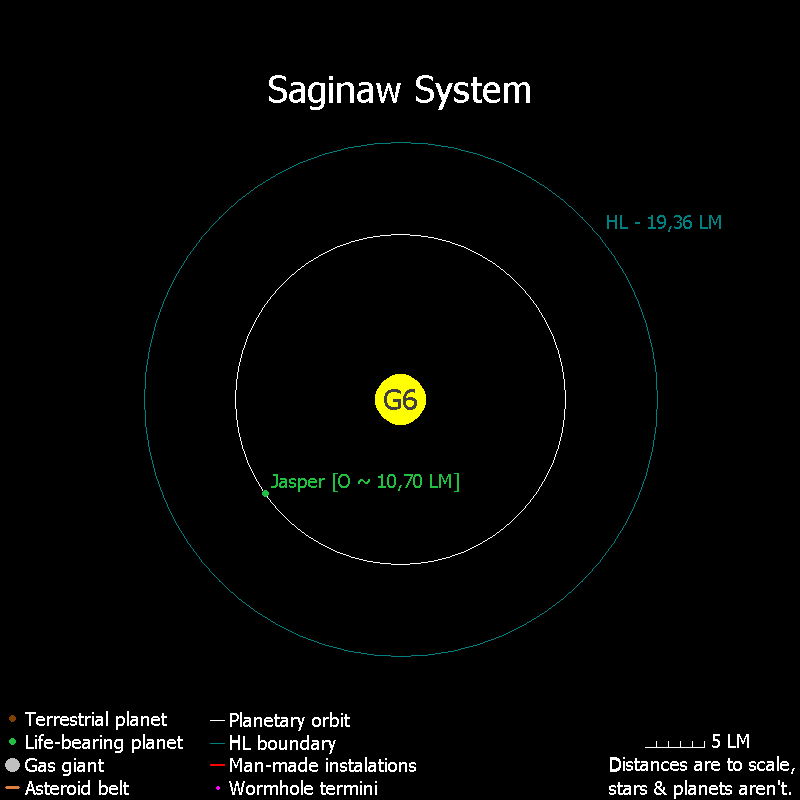
Salamander (Manticore A I) - <JRMN, HoS> The first planet orbiting Manticore A, O – 1,8 [See 2)]; G – 0,25. Salamander has no moons.
Salamis – <David Darke – MtH> see Hope.
Sallah – <IEH> A star system with a PRH base, in IEH still in PRH hands.
Saltash – <SoF> A star system, StC – G8; HL – 18,48 LM [See 3)]. Although nominally independent Saltash has been an OFS client state since 1862 P.D. [See 4)]. The settled planet in the system is called Cinnamon, there is a Casper Belt asteroid belt and one gas giant Himalaya in the system.
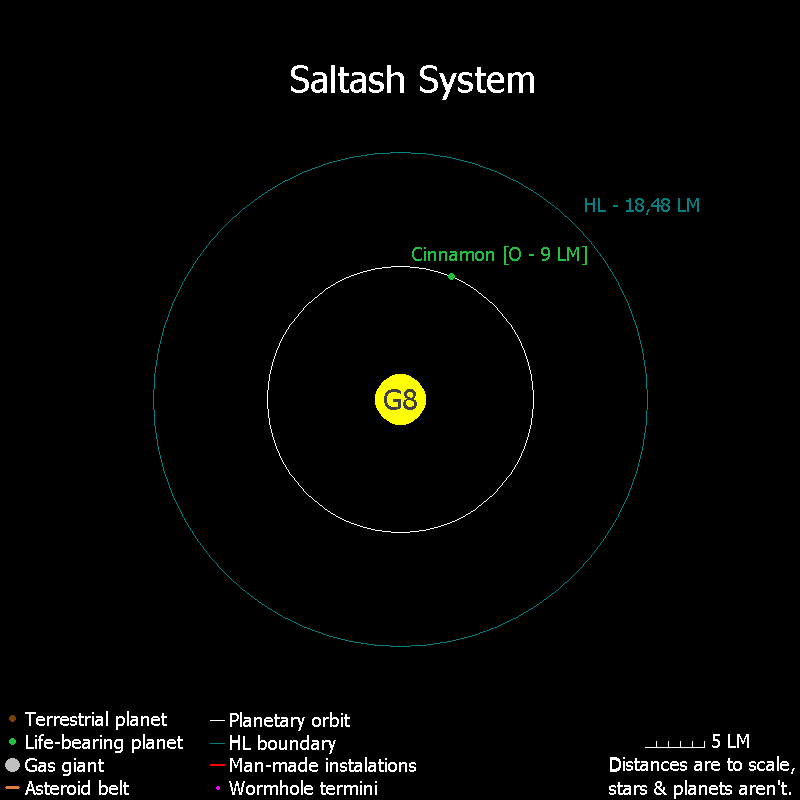
Saltash Delta (Saltash IV) – <SoF> A planet in the Saltash System.
Samovar – <IEH> The settled planet in the Adler System.
Samson – <WarH> A star system on the periphery of Trevor’s Star, former PRH base.
Sandalwood – <OBS> A star system where the great-grandfather of Hamish Alexander commissioned an armchair.
Sandhill – <WarH> A star system in the Breslau Sector of SC.
Sandor – <SoSag> The home planet of Lieutenant Commander Amal Nagchaudhuri's parents, from where they moved to Manticore before he'd learned to walk. The planet's environment causes a complexion approaching albinism.
Sankar – <FS, TW> A star system. Jessica Pheriss moved there with her family from van Mook only to later move to Tasmania.
San Martin– <All -OBS, SVW, FiE, HAE, MtH, CoW, JHRN, ToF, ABF, HTBu9, ART, GNLH, FS, B, TW, CoG, ACtD>The settled planet in the Trevor’s Star System, G – 2,7. It's probably the heaviest gravity world ever colonized. The colonists are all descendants of "people genetically engineered for high-grav enviroments." San Martin's sea-level air pressure is high enough to produce near-toxic concentrations of carbon dioxide and nitrogen. This forced the colonists to restrict their settlements to "moutaintops an high messas of their huge" planet. The planet is very large and has a lot of mountain ranges, several of which put Old Earth's Himalayas and New Corsica's Palermo Range to shame. It is one of the worlds where the native launguage of the colonists, in this case Spanish, is still widely in use alongside the galactic lingua franca - English. The entire orbital industry of San Martin was destroyed by retreating PRH forces. Despite over 30 T-Years of PRH occupation, San Martin's population is still that of a first-rank nation and it has "decent educational, medical and industrial bases."
San Miguel – <SoSag, SftS, SoF, HoS> 1) A star system in the middle of TC, the second member of RTU, now TQ / SEM member. San Miguel is "under" 130 LY away from New Tuscany. There is enough local industry in the system to "provide significant support" to local military forces. 2) The settled planet in the San Miguel System, G – 0,84.
Santander – <FoD> A star system on the frontline in FoD.
Saraquael (Yeltin IX) - <HoS> The ninth planet orbiting Yeltsin, O – 400,3.
Sarawak – <EoH> A star system in PRH, the home system of Commander Susan Phillips, XO on Harriet Benson's watch in Camp Charon on Hades. "One of the liberal-thinkig targets" aquired by PRH "in the early days of the DuQuesens Plan".
Sasebo – <B> A star system inside SL volume. One of the termini of the Erewhon Wormhole junction leads there.
Scarlet – <SoSag, SftS, SoF> A star system in TC, TQ / SEM member, 250 LY away from Lynx and "over" 230 from Lynx Terminus.
Schiller – <HAE, WarH, SotS, HoS> 1) A star system in the southern part of the Posnan Sector of SC, there are at least two gas giants and an asteroid belt in the system [See 5)]. There is a PRH trade legation in the system. 2) The settled planet in the Schiller System. The colonists came from Africa on Earth.
Seabring – <IEH, EoH> A star system in PRH with a navy base. Captured by MA between HAE and IEH, retaken by PRH in EoH.
Seaford Nine – <SVW, EoH, AoV, WarH, SotS, JHRN> A star system, StC – K2; HL – 16,72; There are no planets in the system. The PRH naval base in Seaford, O – 6,02 [See 6)]; was one of PRH's "largest frontier bases" prior to the outbreak of the First Havenite War. The base was captured by forces under Vice Admiral Yancey Parks in the opening battles of the war. The system lost quickly importance mainly because of Hancock's proximity, still there was a small RMN presence throught the war. The system was abandonend after the base was destroyed during Operation Icarus in EoH. Seaford is 10 LY away from Hancock, “near” Zanzibar, Alizon, Yorik and 50 LY from "the nearest settled PRH system".
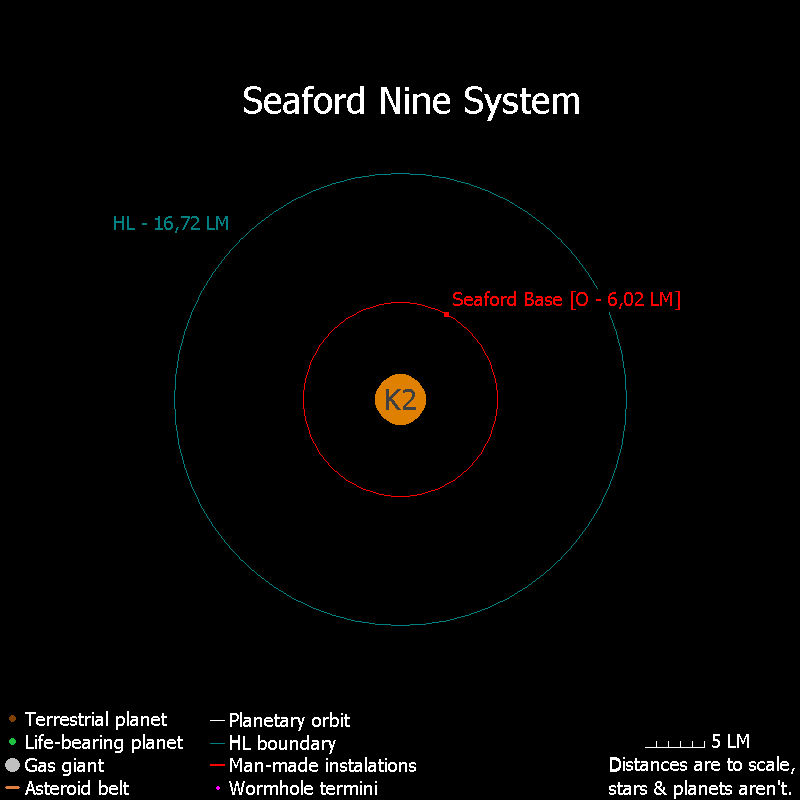
Sebastopol – <ART> A star system in SL. The President of SL Yeou Kun Chol, comes from an old money Sebastopol first family with a 1000 T-Years history.
Secour – <EoH, ACtD> A trinary star system in PRH. The primary component is Secour A, StC – F9; HL – 22,44. There is one settled planet called Marienbad in the Secour A sub-system. The secondary component is Secour B, which is home to a small industrial presence. The trinary component is Secour C, StC – M2; HL – 12,32. There is a gas giant "almost as massive as its star" in orbit. The closest Secour C comes to Secour A is 36 LH.
Seljuk – <WarH> A star system in RoH, “around” 150 LY closer to SC than Haven.
Selker Rift – <HAE, HoS> A volume of space between AE and SC. All ships comming from the Empire that are bound for the Confederacy have to cross it when they change between gravity waves on the way. The hyper-space conditions in the Rift are uncommonly rough with particle density degrading sensor performance more than usual. To make the crossing even more dangerous Selker Rift is also the home of a rouge gravity wave known as Selker Shear. Appearing without any perdictable schedule it poses a deadly threat to any ship within the Rift unable to detect it quickly enough to exit hyper-space. On the far end of Selker Rift from AE is the Sachsen Wave, a grawity wave leading as its name suggests to the Sachsen System
Selkirk – <SftS> A star system. Nicholas Pélisard, the New Tuscany Minister of War went there to visit his family during SftS.
Seraphim – <SoF> A star system in the Madras Sector of SL, 28 T-Days from Montana by dispatch boat.
SGC-902-36-G – <ToF> A star system, StC – M9d; HL – 9,24 LM [See 7)]. Home of the SGC-902-36-G Wormhole Anomaly also known as The Twins. Two secondary wormhole termini lead here, one from the Felix Wormhole Junction, and the other from the Congo Wormhole Bridge. The system lies 40 LY away from any inhabitated system, and is of little interest to anyone. The Mesan Alignment litterally stumbled upon it in the course of surveying the Felix junction.
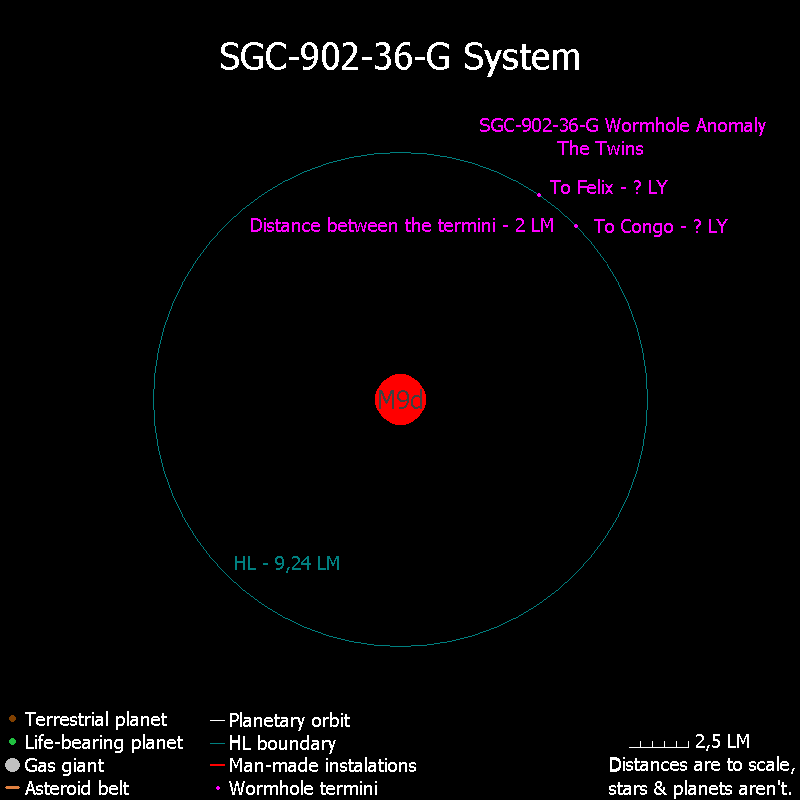
Sharon’s Star – <HAE> A star system in the Posnan Sector of SC, StC – F6; HL – 23,76.
Shadrach – <AAC> The settled planet in the Jouett System.
Shadwell – <CoS> A star system, StC – G5; HL – 19,80; located between Manticore and Erewhon.
Sharpton – <AoV> A planet where the cyborg is a cultural icon. It's routine for an individual to replace limbs and eyes with artificial improvements.
Sheba's Junction – <CoG> A star system "hundreds" LY from Parmley Station.
Sheldon – <OBS> A system conquered by PRH before OBS. A raider was used in the initial fighting.
Sheol – <EoH> The second moon of Hades. The missile platforms emplaced on the surface were destroyed by the escaping prisoners under the command of Fleet Admiral (GSN) Honor Harrington.
Shilo – <EoH> A star system in PRH, SS sector headquarters. It’s 33,75 LY away from Cerberus.
Shingaine – <ART> A star system. In 1852 P.D. [See 8)] a SL sponsored meeting of independent star systems was held there. The result of the meeting was the Shingaine Convention, a wormhole junction usage regulation. SL evisioned it as a pressure tool to be used against independent systems with wormhole junctions, especially SKM. In the end the intent misfired because Manticore didn't sign the convention.
Shona Station – <SoF> The only significant orbital instalation in Cinnamon's orbit with a population of "almost" 250 thousand.
Sidemore – <HAE, IEH, WarH, CoS, SoSag, AAC, SftS, MoH, HoS> The settled planet in the Marsh System. The orbital industry grew quickly after the treaty with SKM was signed. Now the local yards are capable of building light warships and freighters, to provide those with raw materials there are also extraction facilities and smelthers in orbit.
Siegfried – <MoH> A star system in SL. Te local ruler Prince Felix is friends with King Clinton III of New Madagascar.
Sigma – <HAE> A star system in the Posnan Sector of SC.
Sigma Draconis – <OBS, SVW, FoD, MtH, IEH, EoH, AoV, WarH, SoSag, JRMN> A star system "around" 40 LY away from Sol, and 475 LY from Manticore. There is one settled planet in the system called Beowulf. One of the termini of MWJ leads to this system. Since the name Sigma Draconis is rarely used, the system is commonly reffered to as the Beowulf System, a name derived from the planet name.
Silesia – <Timothy Zahn – SotS, JRMN> A star system, the capital of SC.
Silvestria – <Roland J. Green – WoH> A planet settled by two colony expeditions, one using a pre-hyper vessel with cryogenic equipment, the second using a post-hyper ship. Both expeditions were porly organised. The colonists who founded the Kingdom of Chuiban made their voyage in cryogenic suspension, but most of the equipment malfunctioned killing 2/3 of them during the voyage. The hypership colonists that founded the Canmore Republic skimped on supplies, and when they had engine problems that prolonged their journey they were left a shrot step from canibalism. Exausted after their trip they weren't prepared for winter on their new planet and also suffered a 2/3 death rate. That's the reason that the present day population of Silvestria is only five million people. Silvestria is “close” to Erewhon.
Sligo – <HAE> The second most populous star system in AE. There is a settled planet in the system called Erin.
Simiel (Yeltin I) - <HoS> The first planet orbiting Yeltsin, O – 1,0.
Slocum – <HAE> 1) A star system in the Sachsen Sector of SC. <AoV> 2) A star system in PRH. Together with Mylar, MacGregor, and Owens Slocum forms a little square cluster with Barnett at its center. Captured by MA during Operation Buttercup.
Smoking Frog – <CoS, SoSag, AAC, ART> The settled planet in the Maya System, highly industrialized and economically advanced. Smoking Frog's name steems from the planet's vigorous volcanic activity. The planetary, system and sector capital is the city of Shuttlesport. New Tasmania, the smallest continent, is more tectonically stable, lacking the volcanos which give the planet its name, and "blessed with huge expanses of open praire. One of the local export comodities is "beef" that comes from "mayancows". Those are local animals that look like "an undersized brontosaurus crossed with a lama", and unlike real cows are oviparous. Smoking Frog's bio-sculptors are as good as any in the galaxy, except possibly those on Terra or Beowulf. Prior to establising the Kingdom of Torch, Smoking Frog was a planet with the most members of Audubon Ballroom living on it. There is the Eden Habitat in orbit around the planet. Smoking Frog has one moon Vorva.
Socrates – <SoF> The second settled planet in the Meyers System, very similar to Mars but with a "slightly thicker" atmosphere. The planetary population is 32,000. Socrates is the next planet after Meyers in the system.
Sol – <All -SVW, HAE, IEH, WoH, CoW, SotS, GNLH, FS> The capital star system of SL, also known as Old Sol or the Solar System. The system population exceeds 30 billion. It is 48 LY away from Sigma Draconis.
Solon – [See 9)] <FiE, AoV> 1) A star system on the frontline, in the possession of MA in AoV, it guarded the approach to Trevor’s Star. Retaken by RoH during Operation Thunderbolt. <AAC, SftS, MoH, HoS> 2) A star system beyond Haven deep inside RoH. There is a settled planet in the system called Arthur. Solon was attacked by forces under Admiral Honor Harrington during Cutworm III, and was successfully defended by forces under Admiral Javier Giscard. “The system population is over two billion, and its economy was one of the relatively few bright spots for the Peeps even before the Pierre Coup.” There is an asteroid belt, the Nimue Belt, and also at least one gas giant Merlin in the system. Solon lies in a gravity wave.
Solway – <FiE, IEH, AoV, JHRN> A star system with a PRH base guarding Barnett's southeastern flank. It was captured by MA at the same time as Trevor's Star. Re-taken by PRH during Operation Scylla in AoV, abandoned when Operation Buttercup threatened PRH's core worlds it was finally re-captured by RoH in WarH.
Sondermann's Star – <WarH> A star system.
Sphinx (Manticore A IV) – <All -JHRN, ,GNLH> The second settled planet orbiting Manticore A, O – 21,2 [See 10)]; D – 1,09 [See 11)]; G – 1,35; YL – 5,22; DL – 25,62; AT – 14. The atmospheric composition is: N2 - 83%, O2- 15%, Ar - 1%, CO2 - 1%, with a pressure measurement at sea level of 1,39 ATM. Sphinx has a mass of 1,3 [See 12)], and a density of 1,04 of Earth's. Thanks to an unusally thick mantle for its size, the tectonic activity, although higher than Earth's, is actually low for such a big terrestoroid planet. The planet is so far from its star that only an exceptionally active carbon dioxide cycle and in consequence a considerable green house effect makes it habitable at all. The hydrosphere takes 68% of the surface, and the total land surface is 229% that of Earth's. The average surface temperature is 12°C. The low temperature differential between the equator and the poles prevents the formation of ocean currents that otherwise could have had a greater impact on the climate. All those factors combined give Sphinx a "much more active and less inviting climate than Manticore" but in comparison with Earth's the seasonal extreems aren't so great. Sphinx is a "cold world, with huge icecaps (...) and long, slow seasons." There is evidence of a 'recent' glacial retreat caused by the probable relase of CO2 from the Stubelford Traps, a ~8,5 mil. square kilometers area of active volcanism located over a mantle plume hotspot [See 13)]. It's thanks to this "extremly active CO2 cycle that Sphinx remains shirtsleeve-habitable to humans."The planetay biosystem of Sphinx is very similar to Earth's, using the same sugars and "pretty similar" amino acids, genes and chromosomes. A big difference is found in the local equivalent of RNA, which form double strands longer than anything in the terrestial biosphere. All this means that humans and terrestial animals can eat sphinxian plants and animals, and barring some vitamins and trace elements that have to be supplemented, can survive quite OK on them. Despite having been settled since since ~1466 [See 14)] a third of Sphinx's surface is still Crown Land. The major on-planet industries are mining, forestry, and animal husbandry (the planet has vast herds of Terran-adapted cattle and native prongbuck). There are at least five growing seasons for terran plant stocks. Planet-side industry has been slow to develop but has made considerable ground in the last century. Planetary population as of 1920 P.D. was 11 billion humans and 12 million treecats. There are at least four continental masses on Sphinx named Haley's Land, Thule Slocum and Justianna. The Harrington homestead lies 5 km off-shore from the Tannerman Ocean, near Copperwall Moutains "close to" the equator [See 15)], in County Duvalier, Duchy of Shadow Vale on Haley's Land. The nearest city is Twin Forks. In orbit around Sphinx among other industrial constructions, there was, until its destruction during operation Oyster Bay, Vulcan a RMN spase station. The falling debris caused massive destruction on the surface. Yawata Crossing, Sphinx's second largest city was destroyed completly. Tsunami waves hit many costal cities, the city ot Tanners Port was 3/4 damaged. Smaller pieces impacting elsvere on the surface caused other cities to suffer, the formost among those being Evans Mountain, and one treecat clan was wiped out completly. Sphinx has two moons named Perseus and Bellerophon. The tides caused by both moons are less than 10% as high as those occuring on Earth.
Flora & fauna (Treecat names are given in brackets)
All of Sphinx's "mamals" are hexapedal and its wildlife is capable of seeing into the infra-red end of the spectrum. The picket wood (net-wood) is one of Sphinx's most characteristic plants. Reaching up to 45 meters in hight it is one of the rare plants that spreads only through runners and in the air at that. One picket wood three can build a system streaching for "literally hundreds of kilometers in any direction." It's also capable of cutting off infected areas by emmiting celulose-eating enzymes that separate any infected parts creating a barier preventing any spread of the disese.
Other noteworthy species are:
- Condor Owl (death-wing), which despite it's name it doesn't look like a condor or an owl at all. A mamalian nocturnal flying predator, which unlike other sphinxian 'birds' has only a single set of wings.
- Cragsheep (?), a reculsive herbivore species with a body mass around 100 kilograms, the Cragsheep uses its two foremost pair of limbs for grasping and climbing in its mountain habitat.
- Crown Oak (golden leaf), a hardwood tree capable of reaching a hight of up to a 100 meters, changes foliage twice a year.
- Hexapuma (death fang), the biggest sphinxian predator, very quick for its size, extremly territorial. An adult specimen can reach a weight of 800 kilograms, length of 5 meters with a 5,5 meter tail.
- Ice Potato (white-root), a winter growing root twice the size of a potato, edible with a nutty taste.
- Lace Willow (ribbon-leaf), a willow like tree found in marshes. The leaves are capable of forming insect traps.
- Mountain Eagle (peak-wing) a bird analouge with two sets of wings, reaching a length of 1 meter, wingspan of 2,4 meters and a bodyweight between 4,1 and 5 kilograms.
- Near Beaver (lake builder), a mamal approximately 50 centimeters long, an industrious dam builder.
- Near Lettuce (lace leaf), an edible plant with a taste combining lettuce nad onions.
- Near Otter (?), a fast svimer, carnivore hunter the size of a Treecat.
- Near Pine (green-needle), an a fast growing evergreen tree capable of reaching a hight up to 76 meters. It's peanut sized seeds have a nutty flavor and can be crushed for their oil.
- Peak Bear (snow runner), an omnivore living pirimarily in moutainous terrain. Reaching up to 2,5 meters in hight, and a weight of 550 kilograms this ferocious hunter is considered the second most dangerous land animal after the Hexapuma.
- ? (purple thorn), a low, dense, thorned plant. It's bitter-tasting seeds were a necessary component of treecat diet before the modified celery (cluster stalk) was introduced on Sphinx.
- Range Barley (golden ear), an alpine grass, although edible it has an astringent taste. It can be ground into flour and baked or made into porridge.
- Range Bunny (grass runner).
- Red Spruce (gray-bark), an evergreen with a scaled blue-green leaves, reaching a higt of 17 meters. Red Spruce is highly sought after for woodwork.
- Roc Tree (toungue-leaf), a living fossil species reaching up to 13 meters, the Rock Tree contains high concentrations of bonded silicates making it extreemly hard, dense and nearly fireproof for naturally occuring temperatures. Although labor intensive to gather its wood is in high demand.
- Sphinxian Chipmink (burrow runner).
- Spike Thorn / Blossom (?), a shrub reaching a hight of 3,6 meters, with 10 centimeter long sharp thorns and tulip shaped blossoms. Prized for the taste it's pollen gives to honey produced by terrestial bees.
- Tanapple (?), a native fruit shrub looking like an outsized apple with a tart sweet taste.
- Tuskelope (?) a six-legged animal resembling a cross between a musk-ox and a boar, this animal uses its large tusks to dig for roots under snow and ice. Its peak weight appears to be 350 kilograms.
- Wood Rat (bark-chewer), an aboreal, marsupial rodent about a third the size of a treecat.
Treecats
Sphinx is the homeworld of a sapient species called Treecats, who were the twelfth sentinent race encountered by humainty. Treecats rate "0,83 on the sentinence scale, slightly above Beowulf's Gremlins or Old Earth's dolphins". Hexapedal like all of Sphinx’s indigenous mammals, treecats are built long and lean, somewhat along the lines of a Terran ferret or weasel crossed with a lemur monkey. They average about sixty centimeters in body length or about one hundred thirty centimeters overall, including their tails [See 16)]. Treecats are the smallest sapient species discovered by humanity. Perhaps it was their small size that discounted their discovery as tool-makers and fire users, first by the original survey team and later by the colonists themselves. It wasn't until "over" 50 T-Years after the colonisation pf Sphinx, that they were discowered by the 11 year old Stephanie Harrington.
Treecat foremost limbs end in well-developed “true-hands,” each with three fingers and a single opposable thumb. Their mid-limbs end in similar “hand-feet” that are considerably stronger but less agile, and their rearmost limbs end in “true-feet” that have toes, rather than fingers. Each limb's fingers are armed with claws which resemble those of the terrestrial cat but are much boarder at the base. Additionally when retracted they are kept in special "cartilage-lined receptacles". Their composition is more akin to that of the terrestrial shark's tooth. The actual composition of the claw is more like stone than claw or bone, and the inside curve is as sharp "as most obsidian knives." Treecats have definite muzzles, cat-like ears, and round heads that appear somewhat too large for their bodies in comparison to terrestrial cats. Their heads resemble that of a terrestrial bobcat or wildcat but with sharper muzzles, higher foreheads, and no tufts to the ears. Male treecats are universally gray in color, although there are gradations from ’cat to ’cat within that color range. This coloring allows them to blend well with the various colors of picketwood bark. Males also tend to be about fifteen to twenty percent larger than females and, unlike females, grow darker bands around their tails as they age. These “tail rings” make it possible to estimate a male’s age with a fair degree of accuracy. The first ring appears at about four Sphinxian years of age and a new band appears every Sphinxian year thereafter. In addition to being smaller than males and possessing no tail rings, females have dappled coats patterned in brown and white. This coloring allows them to blend in with the leaf-and-sunlight patterns of the upper branch level of the picketwood. A treecat's tail is an evolutionary marvel. Treecats being aboreals use it in a similar way to Earth's monkeys despite the fact that treecat fur is almost frictionless. To overcome this, the tail is a flat piece of muscle that has fur on the outside but is naked on the inside, and unless needed otherwise it's rolled into a tube hiding its funcionality and what's more important preventing heat loss in Sphinx's long winters. The other evolutionary adaptation that helps during longer cold seasons is the tripple fur lining. Similar to a wolf's its designed for maximum heat retention and can be shedded and regrown according to the enviroment's ambient temperature. Their life-span is "well over" 150 T-Years but no longer than "about" 250 T-Years, they remain fretile for 150 T-Years, and there are on "avrege" 4 kittens in each litter.
Treecats are unique among all sapient species for the fact that they don't require a spoken language. This is due to the fact that they are empaths, able to experience emotions of other species, humanity included, and telepaths among themselves. It is thanks to that fact that they have built a highly stable and uniform society. By human standards, ’cats are not naturally innovative. While they are problem solvers, they tend to solve specific problems without generalizing to other applications of the solution. They are capable of making sudden, enormous intellectual leaps as a consequence of the existence of memory singers, female treecats’ who possess the telepathic equivalent of eidetic memory. It is they that spread each technological achievement virtually simultaneously among the clans. Treecat mind capabiliteies alow them to form bonds with humas, such a bond is called an adoption by the human partner.
Treecats are tool-users and fire-users, although the use and control of fire in an arboreal civilization poses certain obvious challenges and threats. Prior to contact with humanity, treecats made tools out of bone, wood, and stone, and wove fabrics and ropes out of the Sphinxian equivalent of hemp and also out of their own shed coats. Although clothing was never necessary for them, they created carry nets, tents, pillows, cushions, and similar textile items.
Treecats are legally considered citizens (albeit as minor children) of the Star Empire and have been since 1568 PD with the passage of the Ninth Amendment to the Constitution. By the same enactment, they hold permanent title to over one-third of the land area on Sphinx. Although it took over eighty T-years, that status as citizens was completely resolved by the passage of the Treecats Rights Bill in 1651. A subsequent decision by the Queen’s Bench Court, the highest court in the Star Kingdom, in 1685 forever banned any legal challenge to the treecats’ status as citizens.
In 1911P.D. treecats established their first extra-Sphinxian colony, when Samantha and Nimitz, accompanied by nine other 'cats took their four kittens to Stedding Harrington on Grayson. Sometime in 1914 their second colony was established in Harrington Duchy on Gryphon. It was also in 1914 P.D. that treecats finally managed to estabilsh a two-way communication with humans, when Dr. Adelina Arif working with Nimitz and Samantha developed a specially adapted form of sign launguage.
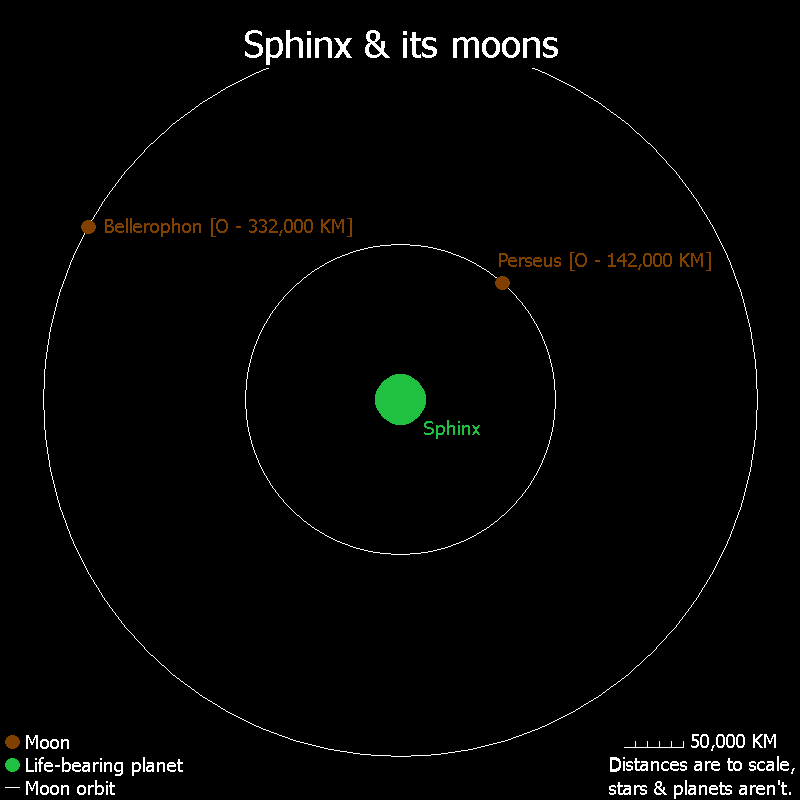
Spindle – <SoSag, SftS, MoH, ART, SoF, HoS> A binary star system in TC, TQ / SEM member and TQ capital system. Spindle is also the location of the Imperial Governor office and RMN Talbott Station headquaters. The Constitutional Convention that determined the Cluster's incorporation into SKM was held there. The primary component is Spindle A, StC – G0; HL – 22. There is one settled planet called Flax and at least one gas giant called Everest in the Spindle A sub-system. Spindle is 60,6 LY away from Split, 83 LY from Montana and "less than" 260 LY from Mesa. The administrative centre for RMN's Talbott Station was established in Spindle after the incorporation of TQ into SEM. There is enough local industry in the system to "provide significant support" to local military forces.
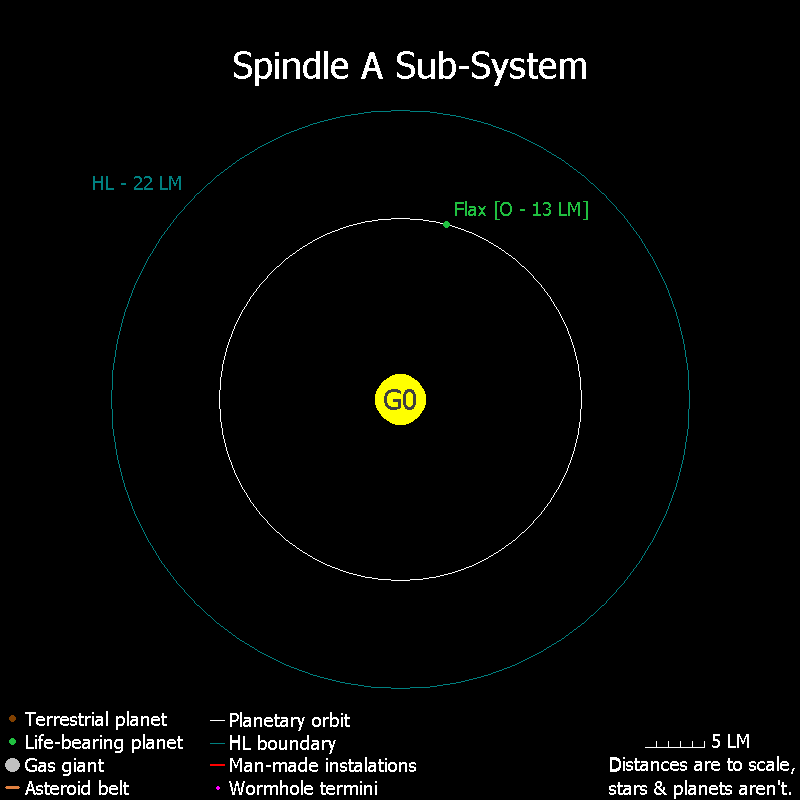
Split – <SoSag, AAC, SftS, HoS> A star system in TC, TQ / SEM member. There settled planet in the system is Kornati. The next closest system to Lynx Terminus after Lynx itself, 120 LY away from Montana and 60,6 LY from Spindle.
Squalus – <AAC> A star system in RoH, its total infrastructure was destroyed during Cutworm I.
Stine – <ART> An star system, StC – G5; HL – 19,80; associated with a wormhole termini. The wormhole connection leads to the Agueda System. The Stine terminus is 5,5 LH from the system primary. It was taken over by RMN during Lacoön Two.
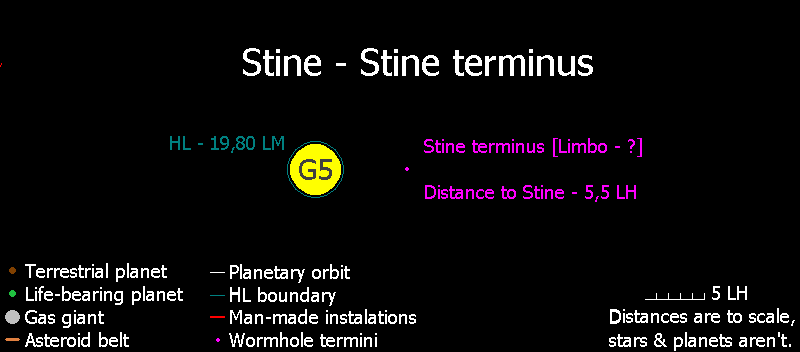
Stotterman – <WarH, HoS> A star system with Switz-like banking law.
Strathmore – <ART, CoG> A star system in OL / SL. Together with Galen's and Kenichi's, Strathmore's system delegation to the SL Assembly is "strongly inclined" to follow Beowulf's example and recommend withdrawal from SL to their system government. Strathmore is within 35 LY of Beowulf.
Suarez – <AAC> A star system in RoH, it was conquered by PRH 36 T-Years before the outbreak of the First Havenite War.
Suchien – <EoH, ACtD> A star system attacked by PRH forces during Operation Icarus.
Sun-Yat – <FiE, AoV, HoS> A star system with a PRH base and “huge” yards, captured by MA in FiE then recaptured by RoH in WarH.
Swallow – <SoF> 1) A star system in the Madras Sector of SL. The system population is over 4 billion in 1922 P.D. The local system economy hac been controlled by Tullah Corporation, a SL transstellar, since 1872 P.D. [See 17)]. 2) The settled planet in the Swallow System, the planetary capital is Capistrano. The planet is known for its spectacular mauntain ranges, among them the Cripple Mountains with 4 peaks at least as tall as Everest with Broken Back Mountain being 250 meters taller.
SXR-136-23 – <WarH> A planetless star system with a red giant as a star, 49 LY northwest from Trevor's Star. The RHN Fleet under Admiral Javier Giscard gathered there before the resumption of active operations in WarH.
Syou-tang– <ART, SoF> A star system under OFS oversight. There is a terminus of the Syou-tang-Olivia Bridge in the system.
1) In IFF we get to know two pieces of data that allow us to make assumptions about Saginaw's StC and HL. The first is that Hawking's message to local traffic control takes "almost" 9 minutes to reach Jasper planetary orbit. The second is the information that Jasper's O is "less than half that of Sphinx", that would make it less than 10,71 LM. So the HL has to be below 19,71 LM, the nearset one is 19,36 for a G6 star. The next one down is a G7 with a HL of 18,92 LM which would make Jaspers distance from HL almost a LM (0,79) shorter, this would make the first piece of data inaccurate, if that were the case I beliewe the better description would be something along the lines of - a little over 8 LM. So taking all that into consideration I decided to settle on STC – G6; HL – 19,36; and Jasper's O ~ 10,7.
2) The table listing the planets of Manticore A in JRMN puts Salamander's orbit at 1,91 LM, but the Manticore A system map in HoS gives 1,8 LM. I'm going with the one from HoS, as it's the newest and most canon material on Manticore A's astrography.
3) Saltash StC isn't given directly in SoF but in Chapter 10 the RMN force makes its hyper transition right on the HL which puts it "over" 9 LM from Cinnamon. Since Cinnamon's O is 9 LM this would make the HL over 18 LM which fits the G8 bracket nicely.
4) SoF takes place in 1922 P.D. at that time Saltash has been "an OFS client for about" 60 T-Years.
5) In HAE Citizen Commander Warner Caslet hides his command PNS Vaubon behind Schiller's “largest gas giant”, so there have to be at least two such planets, and the cover he uses to pass messages to the PRH trade legation in the system is an "asteroid mining boat" so there also has to be an asteroid belt in the system.
6) The PRH force attacking Seaford Nine in EoH emerges from hyper on a least time course for the station, and CIC reports that it's 10,7 LM away.
O = HL - 10,7 LM
O = 16,72 - 10,7 LM
O = 6,02 LM.
7) SGC-902-36-G poses a problem. The StC is given as M8d which should make the HL – 9,68 LM according to the Hyper Limits table from MtH. But a paragraph later the HL is given as 9,24 when we get to know the emergence point of The Twins: "... they were precisely 9,24 LM from the star, which put them exactly on its HL ...". Since it's known that translation from hyper inside HL is impossible I decided that the StC given in the book is a mistake and instead went with the HL, which makes the StC a M9d.
8) In ART Chapter 5 we get the information that the Shingaine Convention took place 70 T-Years ago. ART Chapter 5 takes place in 1922 P.D. which makes the date 1852 P.D.
9) The system mentioned in FiE and AoV and the system from AAC and SftS are definaetly two different star systems. The first one is close to Trevor's Star and the second one is deep inside RoH. So the one from FiE and AoV is actually Solan as the map from AAC clearly shows.
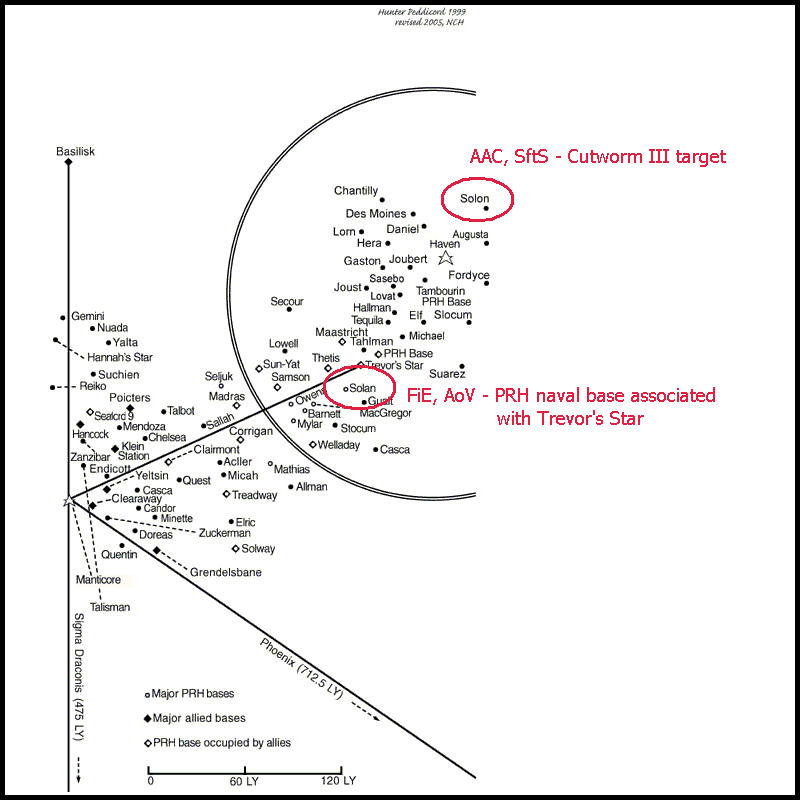
10) In the course of the series we get at least 4 different numbers for Sphinx's O. In AAC we get to know that it is "15.3 million kilometers—less than nine-tenths of a light-minute—shorter than the" HL. 15,300,000,000 meters divided by 299,792,458 m/s gives us ~51 LS, this would make Sphinx's O - 21,15 LM (21'09'').This number is later confirmed in the glossaries of ABF, TW and ART, but JRMN gives the number 21,42 LM (21'25''), and in IFF during a conversation between Charles and Oscar Saint-Just we get the number 27 LS inside the HL which would make Sphinx's O - 21,55 LM (21'33''). Finally in HTBu9 there is 21,22 LM (21'13''), and HoS lists 21,2 LM. I'm going with the one from HoS, as it's the newest and most canon material on Manticore A's astrography.
11) There are two sets of data that describe Sphinx's diameter, one in JRMN - 1,30, and the second one in HoS - 1,09. I decided to use the one from HoS, as it's newer and more canon.
12) There are two sets of data that describe Sphinx's mass, one in HTBu9 - 2,28, and the second one in HoS - 1,3 ("Sphinx is a larger planet, with roughly a third again the mass of Earth"). I decided to use the one from HoS, as it's newer and more canon.
13) In HTBu9 we get the information that the Stubleford Traps are "roughly the size of the region of Brazil on Old Earth." And Brazil's area is 8,514,877 square kilometers, so I rounded trat up to ~8,5 mil.
14) In ABF "With Friends Like These ...," Sub-chapter 13, we get the information that "This entire star system’s been colonized for only about one T-century. The first colonists didn’t land on Sphinx for fifty T-Years after that ..." And the story takes place in the years 1520 - 1521 P.D. Manticore was settled in 1416 P.D., so the earliest date of Sphinx's settlement is 1466 P.D.
15) In SVW Chapter 1 we get the information that the Harrington property lies "barely forty-five degrees below the equator" that's half way to the pole, but in ABF Unexpected Meetings Sub-chapter 1 it is "close" to the equator. I decide to use the ABF data because it is more 'flexible'.
16) WarH gives treecat body length including tail as 1,5 to 2 meters. I decided to use the one from HoS, as it's newer.
17) SoF takes place in 1922 P.D. Tullach Corporation came to Swallow 50 T-Years before that.
- BACK -